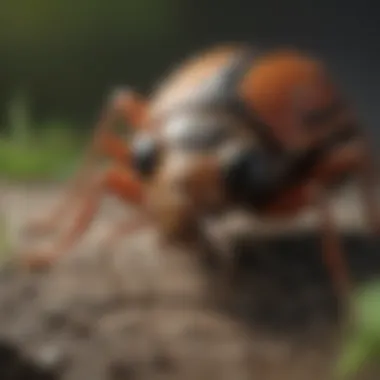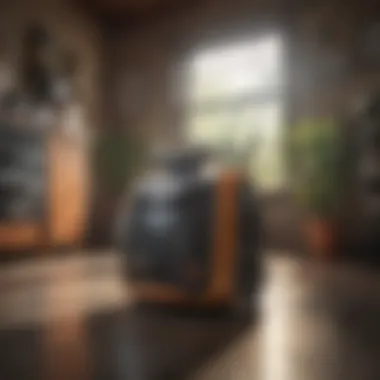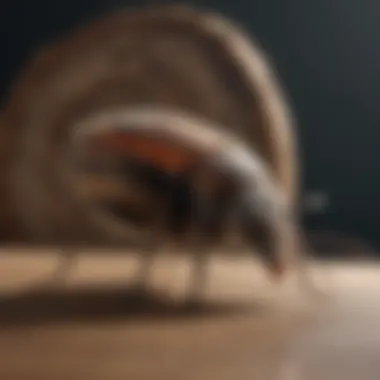Motor City Pest Control: Effective Solutions in Detroit


Intro
In Detroit, often referred to as Motor City, the encounter with pests is a common struggle for homeowners. The urban environment creates a perfect backdrop for various pests to thrive. Understanding how to manage these unwelcome guests is essential for maintaining a healthy living space. This article seeks to unfold effective pest control strategies tailored specifically for the unique climate and environment of Detroit, MI.
Understanding the types of pests prevalent in this region and how to prevent or control them can empower homeowners to take charge of their living conditions. With a blend of traditional and eco-friendly approaches, this guide is designed to cater to both the seasoned gardener and the average householder.
Understanding Pests
Definition of Pests
Pests are organisms that negatively affect human activities, agriculture, or property. They include insects, rodents, and other animals that can invade homes, gardens, and commercial spaces. Common pests in Detroit include ants, cockroaches, rodents, and termites. These creatures not only cause damage but can also pose health risks.
Importance of Pest Identification
Identifying pests accurately is critical for effective control. Different pests require different approaches for management. Misidentifying a pest can result in using the wrong control measures, leading to ongoing problems. Knowing what type of pest you are dealing with allows for targeted solutions, ultimately saving time and resources.
Prevention Techniques
Home and Garden Preventative Measures
Preventing pest infestations begins with simple steps around the home and garden. Here are some effective measures:
- Sealing Entry Points: Inspect your house for cracks and gaps. Seal any openings where pests could enter.
- Proper Waste Management: Keep trash cans tightly sealed and dispose of waste regularly to reduce attracting rodents and insects.
- Maintain Cleanliness: Regularly clean kitchens and dining areas to eliminate food sources for pests.
Seasonal Prevention Tips
Pest behavior often changes with the seasons. Adapting your preventive measures can keep them at bay.
- Spring: As the weather warms up, inspect your home for signs of pests coming out of hibernation.
- Summer: Focus on watering gardens in the morning to avoid attracting insects with moisture in the evening.
- Fall: Prepare your home for colder months by ensuring all entry points are sealed, preventing pests from seeking warmth indoors.
Eco-Friendly Pest Control Solutions
Overview of Sustainable Practices
Many homeowners in Detroit are turning towards eco-friendly pest control options. These methods emphasize safety for both humans and the environment. Integrated Pest Management (IPM) is a sustainable approach that combines different management strategies and practices to grow healthy crops and minimize the use of pesticides.
Natural Remedies and Their Effectiveness
Several natural remedies can effectively reduce pest populations:
- Diatomaceous Earth: This natural powder can be sprinkled in infested areas to kill crawling insects by dehydrating them.
- Essential Oils: Some oils, like peppermint and tea tree oil, can deter pests due to their strong scents.
- Vinegar Solutions: A mixture of vinegar and water can be used to clean surfaces and deter certain insects like ants.
Utilizing an eco-friendly approach not only helps in managing pests but also contributes to a healthier ecosystem.
By employing these strategies, Detroit homeowners can combat pest invasions effectively while maintaining an environmentally conscious approach to pest control. This blend of prevention, identification, and sustainable practices equips residents with the tools necessary for a pest-free life.
Prelude to Pest Control in Detroit
Understanding pest control in Detroit is crucial for residents looking to maintain a safe and healthy living space. The urban environment of Detroit, with its unique climate and industrial backdrop, creates ideal conditions for various pests. The article will present various facets of pest management that can equip homeowners and gardening enthusiasts with essential knowledge for managing and preventing pest infestations.
Homeowners should realize that pest control is not just a one-time activity. It requires continuous efforts and smart strategies to keep their homes secure from infestations. The key benefit of effective pest management is the prevention of potential health risks and property damage associated with pests.
Moreover, this section provides insights into why it is especially important to address pests in urban settings like Detroit. High population density, combined with factors like poor waste management and dilapidated structures, can lead to increased pest activity. Residents must be proactive rather than reactive when dealing with pests, tailoring their responses to fit their specific circumstances.
By diving deep into pest control strategies in the Motor City, the article aims to foster a nuanced understanding of how pest management works in urban environments and why it is vital for keeping homes pest-free.
Common Pests in the Detroit Area
Understanding the common pests that inhabit Detroit is crucial for effective pest management. Urban areas are particularly susceptible to infestations due to dense populations and varying living conditions. Recognizing the presence of pests early on allows for timely interventions, preventing more significant problems in the future.
Rodent Issues
Rodent infestations are a major concern for Detroit residents. Species like the house mouse and the Norway rat thrive in urban environments, drawn by the availability of food and shelter.
These rodents can quickly reproduce, making a small problem escalate into an overwhelming situation. They are known carriers of diseases and can cause severe property damage as they gnaw on wires and insulation. Effective management starts by identifying signs of infestation— droppings, tracks, and nesting materials are common indicators.
Controlling rodent populations requires a combination of sanitation measures, such as keeping food sealed and reducing clutter, along with traps or deterrents. Homeowners must stay vigilant in monitoring for signs even after initial control measures.
Insects: Ants and Cockroaches


Ants and cockroaches are prevalent in many homes across Detroit. These insects invade kitchens and pantries, seeking food.
Cockroaches can trigger allergies and asthma, particularly in children. They are nocturnal and can multiply quickly. Preventive steps include maintaining cleanliness and sealing cracks and crevices that serve as entry points.
Different types of ants can also appear, each necessitating unique control methods. For instance, the dreaded carpenter ant can cause structural damage to wood. It's essential to identify the species for targeted intervention. Utilizing baits and professional insecticides may be needed for significant infestations.
Termite Threats
Termites are another concern, particularly in older homes. Here, they can silently cause extensive damage over time. The Eastern subterranean termite is common in Michigan and can compromise the integrity of wooden structures.
Detecting termite damage early is challenging. Signs include mud tubes, discarded wings, or hollow-sounding wood when tapped. Homeowners should consider regular inspections and preventive treatments, especially before renovations.
Knowledge of their biology can aid in control. Treatments may include soil applications and baiting systems designed to eliminate colonies effectively.
Wildlife Intrusions
Wildlife in Detroit, like raccoons and possums, can lead to significant pest control issues. These animals often seek shelter in attics or basements, attracted by easy access to food.
They can create noise disturbances and potentially damage property. Homeowners must exercise caution when dealing with wild animals, and it is advisable to contact professionals who understand local laws regarding wildlife removal.
Preventing wildlife interactions involves securing trash bins and maintaining gardens by trimming back overgrown vegetation. Physical barriers can also be effective in keeping these animals from entering living spaces.
Pest Identification Techniques
Pest identification stands as a crucial first step in effective pest control. Knowing what pests you are dealing with can shape your response strategy. Accurate identification enables homeowners to choose the most effective treatment options, whether they are considering preventive measures or curative actions. Misidentification can lead to inappropriate treatments, escalating the problem rather than resolving it. Thus, understanding pest behavior, habits, and habitats is foundational to a successful pest management approach.
Visual Inspection Methods
Visual inspection is one of the simplest yet most effective methods of pest identification. Homeowners can start this process by conducting thorough inspections of their properties. Signs of pest activity can include droppings, gnawed materials, or nests. It is critical to pay attention to areas that are often overlooked, such as basements, attics, and garages.
- Look for droppings: Different pests leave different types of droppings. Identifying these can immediately point to the pest type.
- Nesting materials: Rodents often use shredded paper, fabric, or insulation to create nests. Finding these can indicate an infestation.
- Physical damage: Chewed wires, holes in walls, or signs of wood damage are red flags that should not be ignored.
A flashlight can aid in revealing hidden areas where pests might be lurking, enhancing the chances of early detection. Written notes during inspections can be valuable for tracking pest types and locations.
Utilizing Traps for Identification
Traps serve dual purposes: they can capture pests and help identify them. Different traps are designed for varied types of pests.
- Snap traps: Used primarily for rodents, they allow for easy identification of the caught pest once triggered.
- Glue traps: Effective for both insects and small rodents. They show pests when you notice such traps in place, and you can often identify the type caught.
- Bait traps: These can attract specific pests, indicating the type of infestation based on the bait used.
When setting traps, choose locations where you suspect the most activity. Regular inspections of these traps will not only give you a sense of the pest count but also help corroborate any visual findings.
Recording and Reporting Pests
Documenting pest sightings plays a vital role in identification and management. Keeping a log can help track trends over time, such as increases or decreases in pest activity. This practice can be especially important when collaborating with pest control professionals.
"Vigilant recording can lead to effective pest management strategies."
Key components to include in records:
- Date and time of sighting
- Type of pest identified
- Location of sighting
- Signs or damages noted
Utilizing applications or simple spreadsheets can streamline this process. Patterns that emerge over time may guide preventive actions, as well as provide crucial insight into ongoing issues that need immediate attention.
Preventive Measures for Pest Control
Preventive measures are essential in pest control. Taking steps to avoid pest infestations saves time, money, and resources. By focusing on proactive solutions, homeowners can create an environment less prone to pest problems. This not only protects the home and property but also contributes to a healthier living space for all residents.
Structural Modifications
Structural modifications involve changes to the physical aspects of a home to deter pests. This can include sealing cracks and crevices in walls, windows, and doors. Small openings allow easy access for insects and rodents. It is important to routinely check these areas, especially in older homes, where wear may create new entry points.
Another effective strategy is installing screens on doors and windows. This helps keep pests out while allowing airflow and natural light. Additionally, using weather stripping can also prevent drafts and close tiny gaps. Structural stability not only improves energy efficiency but also minimizes potential pest harborage.
Sanitation Practices
Sanitation practices are fundamental in pest control. Keeping all areas of the home clean and free from food debris is critical. Regularly cleaning kitchens and dining areas will significantly reduce food sources for pests. For example, crumbs or spills should be cleaned immediately, and garbage should be disposed of properly and frequently.
It is also wise to pay attention to pet food. Storing it in sealed containers protects it from pests. Moreover, regular vacuuming and sweeping help eliminate potential pest habitats. By maintaining a high standard of cleanliness, homeowners can significantly lower the risk of infestations.


Landscaping Strategies
Landscaping strategies play a vital role in pest prevention. The space around a home should be designed to minimize risks. For instance, keeping plants trimmed and away from the house can prevent pests from finding easy routes indoors.
Using pest-resistant plants can also be effective. Certain plants naturally repel pests, reducing the need for chemical solutions. Moreover, maintaining proper drainage away from the house can prevent water accumulation, a common attractant for pests such as mosquitoes and termites.
In summary, preventive measures significantly enhance pest control efforts. Structural modifications, diligent sanitation practices, and strategic landscaping can collectively create a protected environment, minimizing the likelihood of pests taking hold.
"An ounce of prevention is worth a pound of cure."
Adopting these measures leads to a more secure living condition and fosters a healthier lifestyle.
Eco-Friendly Pest Control Solutions
The need for eco-friendly pest control solutions continues to grow, especially in urban areas like Detroit. This is mainly because of increasing awareness about the effects of chemicals on health and the environment. Households are looking for ways to manage pests without harming their families, pets, or the ecosystem. Eco-friendly options can effectively control pest populations while minimizing ecological harm. Adopting these strategies demonstrates a commitment to sustainability and encourages healthier living spaces.
Organic Pesticides
Organic pesticides are derived from natural sources, making them less harmful than their chemical counterparts. These products often have fewer toxins, which means they are safer for humans and animals. Examples include neem oil, diatomaceous earth, and insecticidal soaps. Each works to target specific pests while preserving beneficial organisms in the garden.
Benefits of Organic Pesticides:
- Reduced risk of toxic exposure.
- Environmentally safe, reducing pollution.
- Promotes biodiversity in garden ecosystems.
While effective, the application of organic pesticides requires some understanding. It is important to read labels carefully and follow recommended usage. Do not underestimate their potency; misuse can lead to ineffective results or harm to non-target species.
Natural Repellents
Natural repellents are an excellent choice for keeping pests at bay without using harmful chemicals. Many common scents in nature deter insects. For instance, peppermint oil can repel ants and spiders. Similarly, citronella is well-known for deterring mosquitoes.
Here are some popular natural repellents:
- Garlic: A strong odor that pests avoid.
- Lavender: Effective against moths and fleas.
- Cinnamon: A deterrent for ants.
Homeowners can utilize these in various ways, such as mixing them with water and spraying them around their homes or gardens. The considerations here focus on frequent reapplication since natural repellents tend not to last as long as synthetic options.
Integrating Biological Control
Biological control involves using natural predators to manage pest populations. This is a long-standing method, emphasizing balance in ecosystems. For example, ladybugs can control aphid populations, and certain types of nematodes can target fungus gnats in soil.
Key Points about Biological Control:
- Works synergistically with organic methods.
- Can lead to sustainable pest management.
- May require initial investment but saves money in the long run.
Implementing biological control is about observation and patience. Homeowners must identify specific pest problems and select appropriate natural enemies. As with any strategy, it's crucial to research and plan accordingly to ensure the best outcomes.
Professional Pest Control Services in Detroit
Pest control plays an essential role in maintaining a healthy living environment. In Detroit, the presence of pests can escalate quickly, leading to potential health risks and structural damage. Professional pest control services are crucial for effectively managing these threats. Opting for these services not only ensures a comprehensive approach to pest eradication but also alleviates the burden from homeowners who may lack the expertise or time for DIY pest management.
Choosing the Right Pest Control Company
Selecting a pest control company requires careful consideration. Homeowners should look for licensed and insured companies. This provides a level of security and confidence in their qualifications. Reviews and testimonials can serve as valuable resources in evaluating a company’s reputation. Customers should ask about the specific methods used, particularly if they are interested in eco-friendly options. Some companies might offer a blend of traditional and advanced techniques, which is worth exploring.
When making a decision, consider the following factors:
- Experience in the field
- Knowledge of local pest concerns
- Customization of services to fit individual needs
- Response time in emergencies
A good pest control company will also offer a comprehensive inspection prior to any treatment. This typically includes assessments of entry points, hygiene practices, and conducive conditions for pests. Homeowners need to feel comfortable asking questions about the processes to ensure transparency.
Understanding Service Agreements
Service agreements are an important component of hiring professional pest control services. It is vital to understand the terms and conditions before committing. A clear service agreement outlines the scope of work, frequency of visits, and the types of pests covered. Homeowners should inquire about guarantees provided and what actions are taken if pests return after treatment.
Typically, agreements can vary in length. Some companies might offer one-time services, while others propose ongoing contracts. The latter can be beneficial for continuous protection against recurring issues. It’s also essential to check for clauses regarding cancellation and renewal terms.
"A well-structured service agreement not only protects the homeowner but also establishes a clear framework for the pest control company’s responsibilities."
Legal Considerations for Pest Control


As pest management gains importance in urban environments like Detroit, understanding the legal aspects of pest control becomes crucial. Incorrect handling of pest control services can lead to various legal liabilities for both companies and homeowners. Regulations are in place to ensure safety, effectiveness, and environmental considerations. Understanding these legalities not only creates a foundation for responsible pest control but also helps maintain community health.
Regulations Affecting Pest Control Companies
In Detroit, pest control companies must adhere to specific regulations established by both state and federal authorities. These regulations often include licensing requirements, proper pesticide application protocols, and guidelines for safe disposal of hazardous materials. Companies using pesticides must be certified to assure the public that they follow safe practices. This is particularly relevant in a city where urban density can heighten risks associated with pest infestations.
Points to consider regarding regulations:
- Licensing: Companies must hold appropriate licenses to operate legally within Michigan. This ensures that they are equipped with the knowledge to apply treatments safely.
- Pesticide Management: There are strict guidelines on what substances can be used. Only approved pesticides can be employed, and they must be applied in a manner that minimizes exposure to humans and pets.
- Environmental Impact: Regulations also emphasize the need for environmentally conscious practices. Companies may be required to provide safety data sheets for all products used.
"Understanding local regulations is essential for ensuring effective and safe pest management practices."
Adhering to these regulations not only protects the public but also establishes trust between pest control companies and their clients.
Homeowner Responsibilities
Homeowners play a vital role in the pest control process. Their responsibilities encompass understanding the legalities involved, maintaining their property, and communicating effectively with pest control providers. Knowledge of these responsibilities fosters a more productive relationship with service providers, ensuring better outcomes.
Key homeowner responsibilities include:
- Research: Homeowners should verify that pest control companies are compliant with the relevant regulations. This can be done by checking licensing and insurance coverage.
- Reporting: Timely reporting of pest problems can prevent significant infestations. Homeowners should document pest sightings and any related damage to inform pest control specialists thoroughly.
- Compliance: After pest control treatments, it is crucial for homeowners to follow any recommended protocols, especially regarding pets and children. Ensuring that the treated areas are not disturbed for the advised period enhances treatment efficacy.
By being aware of and fulfilling these responsibilities, homeowners contribute to a safer and more efficient pest control process, ultimately preserving their living environment.
The Role of Technology in Pest Management
Pest management has evolved significantly due to technology. The use of advanced methods markedly improves identification and control of pest issues. In urban environments like Detroit, adopting these technologies in pest control provides better outcomes for residents.
Technology serves multiple purposes in pest management: enhancing efficiency, accuracy, and response time. Homeowners can access tools and resources that enable proactive pest control, limiting infestations before they escalate. This shift is crucial; it allows for a more informed approach to pest management, important in urban settings where pest threats are more prevalent.
Pest Control Apps and Software
Pest control applications have grown in popularity. These platforms often offer valuable insights into pest management practices. Many apps help users identify pests through insect photographs. Homeowners can type in specific characteristics or upload images to receive relevant information about pest species.
Some notable features of pest control apps include:
- Identification and Tips: Users can learn to identify pests specific to their region, minimizing misdiagnosis.
- Tracking Occurrences: Keeping records of pest sightings can help track patterns and make informed decisions.
- Treatment Guidelines: Apps provide recommended treatments based on the identified pests, including eco-friendly options.
By integrating technology into pest management, homeowners can make better decisions without being pest control experts. These resources enhance communication between residents and pest management professionals, creating a more robust approach to keeping homes pest-free.
Utilizing Drones in Pest Monitoring
Drones are transforming pest control by offering an aerial perspective that was previously unavailable. They allow for extensive monitoring of properties, especially larger areas like gardens and farms. The ability to capture images helps identify pest populations and breeding grounds.
Some advantages of using drones include:
- Wide Coverage: Drones can cover large areas relatively quickly, identifying pest problems that are hard to see from the ground.
- Real-time Data: The real-time capability of drones means pests can be monitored around the clock. This constant surveillance is valuable in assessing pest activity and planning responses accordingly.
- Targeted Treatments: Instead of blanket pesticide applications, drones can pinpoint areas of concern, allowing for targeted and efficient pest management.
With drones, homeowners gain access to innovative pest monitoring solutions. Utilizing such technology enables a shift from reactive to proactive pest management strategies, vital in urban living environments.
"Adopting technological solutions in pest control allows for smarter, more efficient methods of prevention and treatment."
As pest management practices incorporate technology, homeowners in Detroit can expect better, more effective solutions for pest control challenges.
Ending: Staying Informed and Proactive
Understanding pest control goes beyond mere reaction. It is about adopting a mindset that values continuous learning and proactive strategies. In the context of Detroit, where urban living can exacerbate pest problems, being well-informed plays a crucial role in preventing infestations before they start. Homeowners must recognize that pest management is not simply a one-time solution but an ongoing process that demands attention.
Continuous Education on Pest Management
Education in pest management can be a significant asset for homeowners. Knowledge about pests commonly found in Detroit, such as rodents and termites, aids in early detection. Being aware of the life cycles and behaviors of these pests enables more effective prevention strategies. Many resources are available:
- Workshops and Seminars: Participating in local workshops can provide insights into the latest pest control techniques and products.
- Online Courses: Websites like Britannica offer educational content on pest management.
- Homeowner Guides: Local extensions or gardening clubs might have guides available to help understand pest control in residential areas.
Furthermore, sharing knowledge through community forums like Reddit can foster collective awareness and solutions. The more informed individuals are, the more effective they can be in addressing pest issues.
Building a Healthy Living Environment
Creating a healthy living environment is intertwined with proper pest management. A clean, well-maintained home naturally discourages pests. Homeowners should consider the following practices:
- Regular Cleaning: Ensuring that areas are frequently cleaned minimizes food sources for pests.
- Sealing Entry Points: Simple measures to seal gaps in windows and doors can prevent pests from gaining access.
- Proper Waste Management: Maintaining waste separation and timely disposal can significantly reduce attracting unwanted critters.
Maintaining a healthy home is not just about keeping pests out; it also ensures the safety and well-being of families. Ultimately, the proactive measures taken today can lead to a more peaceful, pest-free living space in the long run.
"The best defense is a good offense."



